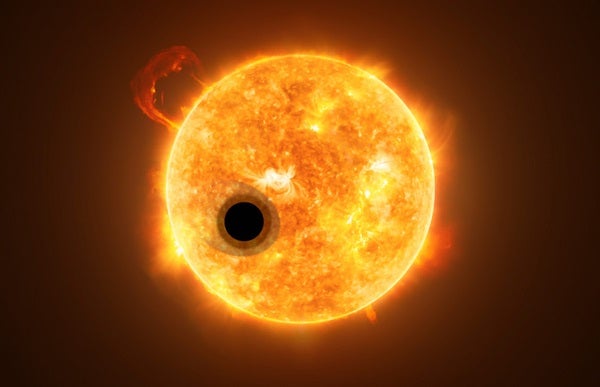“Helium is the second-most common element in the universe after hydrogen. It is also one of the main constituents of the planets Jupiter and Saturn in our solar system,” said lead author Jessica Spake of the University of Exeter, in a press release. “However, up until now, helium had not been detected on exoplanets — despite searches for it.”
Furthermore, the helium signal the researchers discovered was so strong that they think the planet’s upper atmosphere may stretch many thousands of miles into space, making it susceptible to erosion through intense stellar winds. According to the study, this wind-induced erosion is also likely creating an extended, comet-like tail of gas around the exoplanet, which causes the planet to shed up to 4 percent of its total mass every billion years.
“The helium we detected extends far out to space as a tenuous cloud surrounding the planet,” said co-author Tom Evans of the University of Exeter, in a press release. “If smaller, Earth-sized planets have similar helium clouds, this new technique offers an exciting means to study their upper atmospheres in the very near future.”
The traditional method for studying exoplanetary atmospheres is to observe them in ultraviolet or optical light, which both have relatively high energies. However, this new study focused on infrared light, which has a much longer wavelength (and, therefore, lower energy) and passes directly through Earth’s atmosphere. Previous ultraviolet-based searches required orbiting space observatories to investigate the chemical makeup of an exoplanet’s atmosphere. But, by proving that infrared light can also be used, astronomers have shown that ground-based telescopes can help study the air around exoplanets, too.
“The strong signal from helium we measured demonstrates a new technique to study upper layers of exoplanet atmosphere in a wider range of planets,” says Spake. “Current methods, which use ultraviolet light, are limited to the closest exoplanets. We know there is helium in the Earth’s upper atmosphere, and this new technique may help us to detect atmospheres around Earth-sized exoplanets — which is very difficult with current technology.”
Although future projects could use telescopes here on Earth to study exoplanets, the technique may be even more valuable for future space-based observatories. “We hope to use this technique with the upcoming James Webb Space Telescope, for example, to learn what kind of planets have large envelopes of hydrogen and helium, and how long planets can hold on to their atmospheres,” said Spake. “By measuring infrared light, we can see further out into space than if we were using ultraviolet light.”
Want to brush up on the basics of exoplanets? Download our FREE exoplanet e-book!











